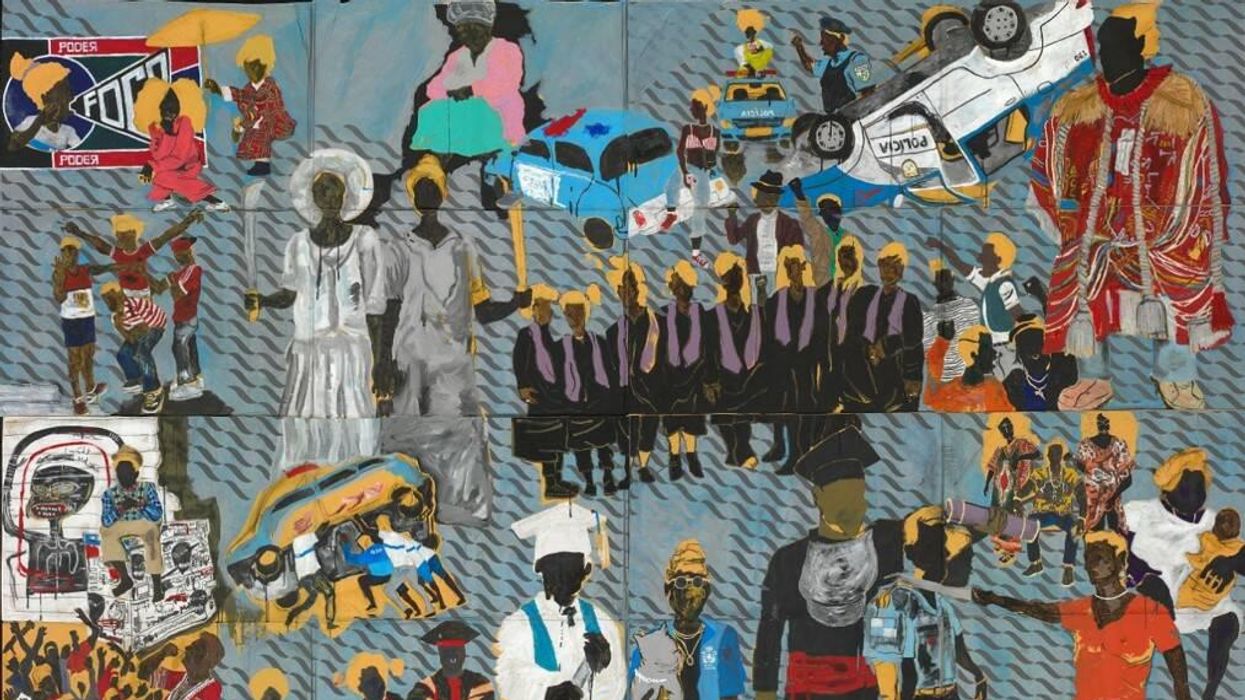Sprawling New MFAH Show Illustrates the History of Transatlantic Slave Trade

'We were the ashes and now we are the fire,' by Maxwell Alexandre, 2018
IN PORTUGUESE, THE word histórias, or histories, refers to both truth and fiction, and how the past can be read (or misread) from a multiplicity of perspectives. Afro-Atlantic Histories, which debuted at the Museu de Arte de São Paulo (MASP) as Histórias Afro-Atlânticas in 2018 and is currently on view at MFAH through Jan. 17, 2022, is a cumulative and complex reading of the history and legacy of transatlantic slave trade as seen through the eyes of the artist.
The exhibit includes more than 130 artworks made in Africa, the Caribbean, the Americas and Europe, from the 17th to the 21st centuries, with an emphasis on artists who have been and continue to be underrepresented in museums.
While Afro-Atlantic Histories is expansive, it never feels overbearing or claustrophobic. Paintings, drawings and prints, sculptures, photographs, videos, and historical ephemera are installed across six galleries on the MFAH's second floor, with additional works from the museum's collection on the mezzanine. Each piece is given plenty room to breathe, compelling visitors to slow down, take in what they're seeing, and retrace their steps as the thematic interplay between the galleries and works on display takes hold.
For example, in the gallery organized under the theme "Maps and Margins," patrons encounter Aaron Douglas' 1936 painting Into Bondage, which depicts of group of chained men in silhouette boarding a slave ship. Besides being a stunning example of Douglas' unique "Afro-Deco" style, the painting is emblematic of a specific time in African American culture, when artists were breaking free of the expectations of critics and conservative members of their community with regard to what subjects a black artist should or shouldn't explore in their work.
In the same gallery, this defiant spirit is palpable in the hand-carved sculpture of a slave ship by Brazilian artist José Alves de Olinda, where a dozen Yoruba deities armed with spears stand guard above deck, perhaps sailing the ship back to its African port. In another gallery, Elizabeth Catlett's small bronze sculpture Standing Mother and Child absolutely radiates in its depiction of unconditional love, something any parent and child will recognize, regardless of the color of their skin.
But within earshot of this gentle moment is Venezuelan artist Victoria Santa Cruz's 1978 video Me gritaron negra (They shouted black at me), where the artist, accompanied by a group of dancers dressed in everyday clothes, describes in rhythmic, poetic language, her transformation being feeling ashamed, then proud of the color of her skin, concluding with the chant, "Negro! Negro! Negro! Negro! I'm a black woman!" It's an exhilarating example of time-based art, made all the more powerful when experienced in tandem with the aforementioned Catlett sculpture, or any of the other works on display.
Whether or not this beautiful, thoroughly researched and intelligently curated exhibition will inspire museums to admit to and address their own histories of colonialism and institutionalized racism remains to be seen. But for now, Afro-Atlantic Histories gives visitors the opportunity to consider how profoundly the past shapes the present, and what we as individuals and as a community can do to create a better future.

'Conversation,' by Barrington Watson, 1981

'Self-Portrait as Liberated American Woman of the 70s,' by Samuel Fosso, 1997

'Standing Mother and Child,' by Elizabeth Catlett, 1978
- Two New Exhibitions Coming to the MFAH This Fall Will Provide ... ›
- First Touring Retrospective of Visionary Colombian Fiber Artist Olga ... ›
- Final Component of New MFAH Campus Opening Soon - Houston ... ›
- MFAH's Kinder Building Hosts First Gala — and It Was Truly 'Grand ... ›
- From Paris with Love: Inside MFAH's $1.2 Mil Grand Gala Ball - Houston CityBook ›
- From Obama to Optical Illusions: Ambitious Spring Season Awaits at MFAH - Houston CityBook ›
- MFAH Unveils New Displays for European Arts — Including Several Never-Before-Seen Pieces - Houston CityBook ›
- Tabled So Curators Could Add ‘Perspectives’ Following George Floyd's Murder, this Poignant Show Is Up at MFAH - Houston CityBook ›
- Life and Legacy of Big-Time Benefactor Celebrated at MFAH’s Grand Gala Ball - Houston CityBook ›
- MFAH Installs Two Provocative Paintings in its Foyer, Presenting Them Together as a 'Portrait of Courage' - Houston CityBook ›
- Time-Travel to Paris via MFAH's Latest Exhibit of European Masterpieces - Houston CityBook ›
- A Trio of Contemporary-Cool Shows Bows at MFAH This Weekend - Houston CityBook ›
- Two Award-Winning Photographers Capture ‘Vanishing Americana’ in New MFAH Show - Houston CityBook ›
- Hip-Hop, Trill Burgers, Lynn Wyatt and Warhol! Go Inside MFAH’s $2 Million Gala Night! - Houston CityBook ›














